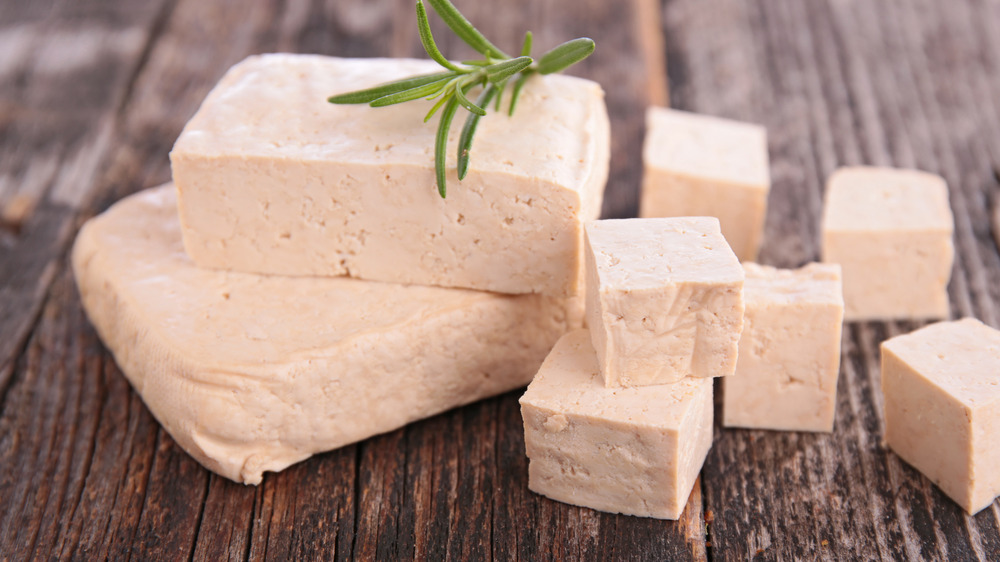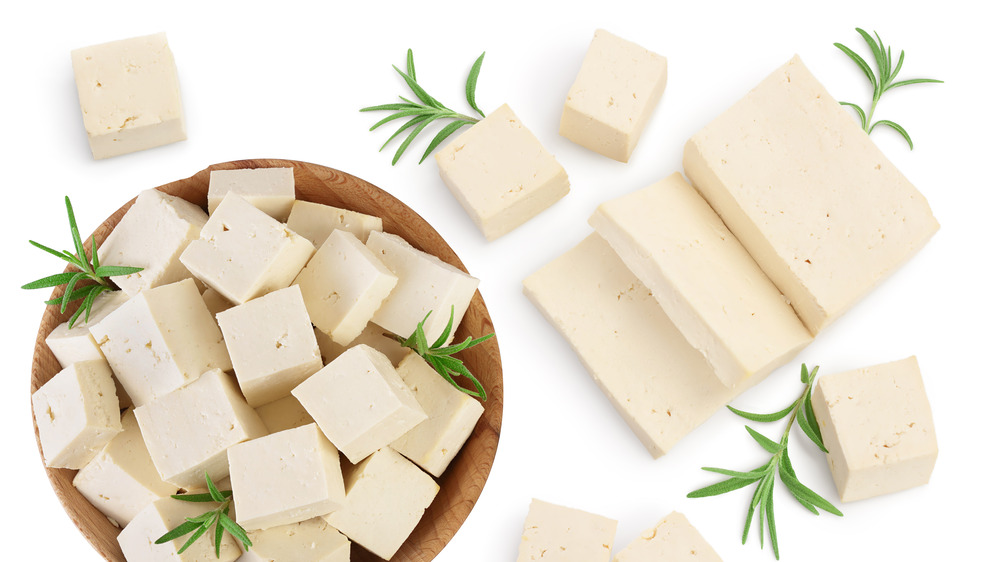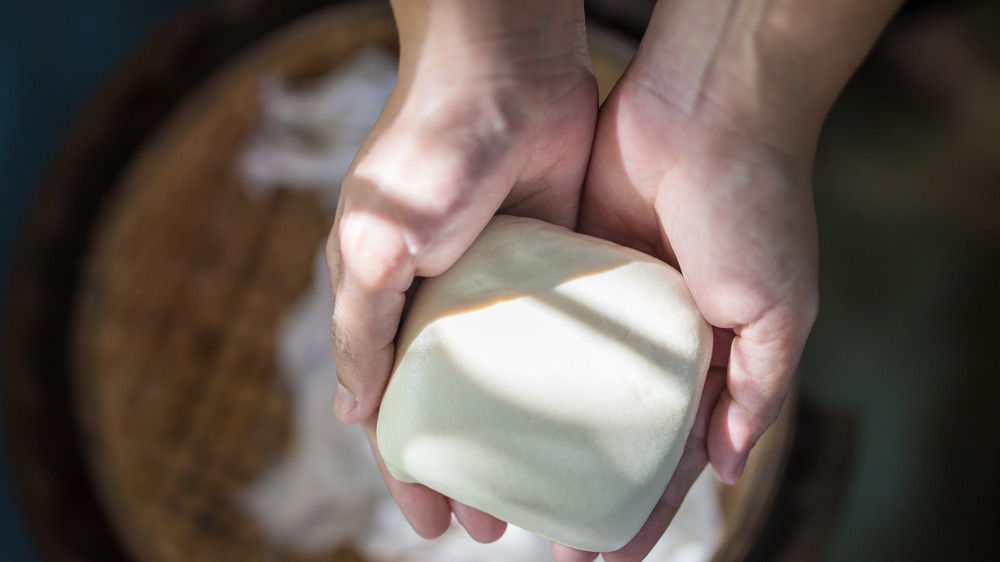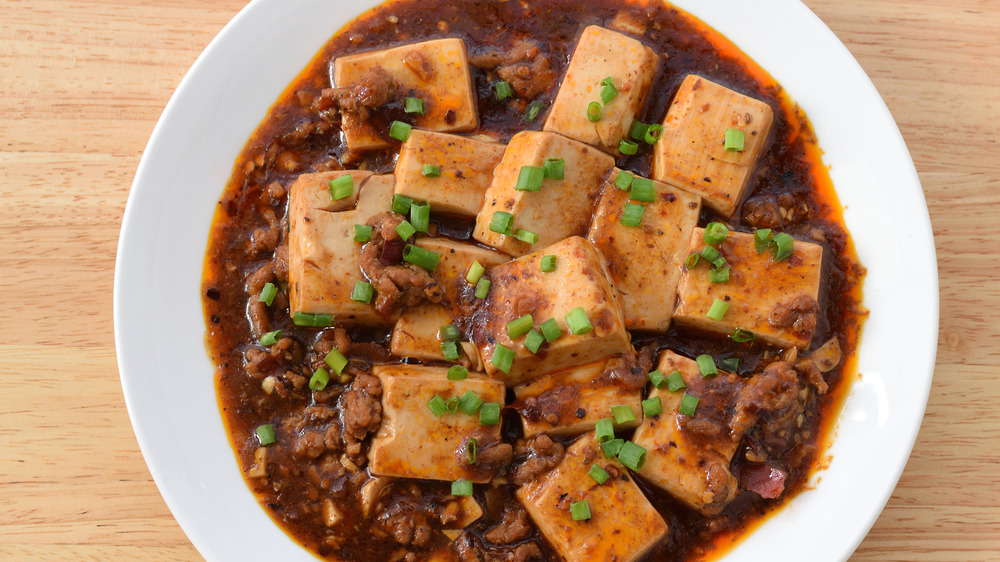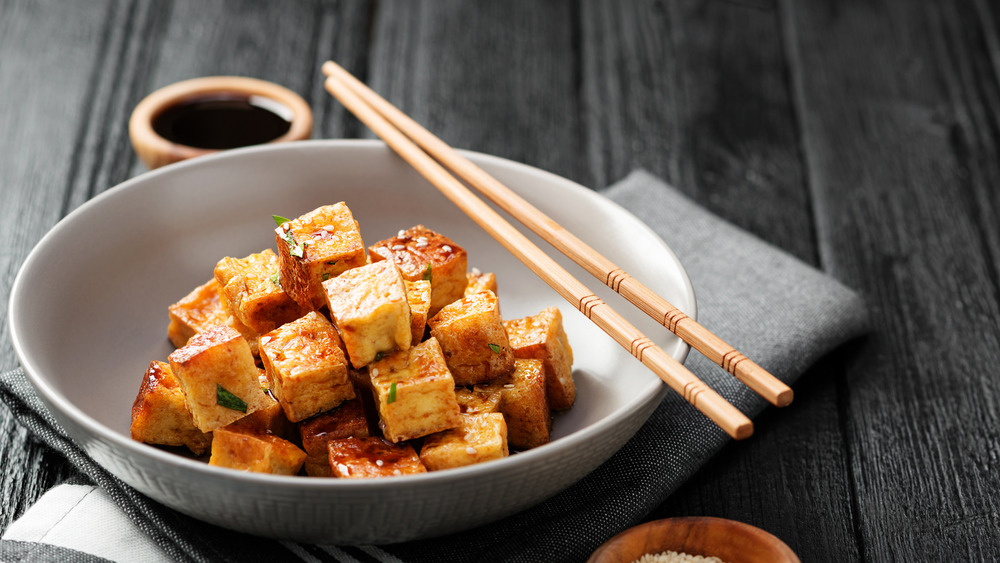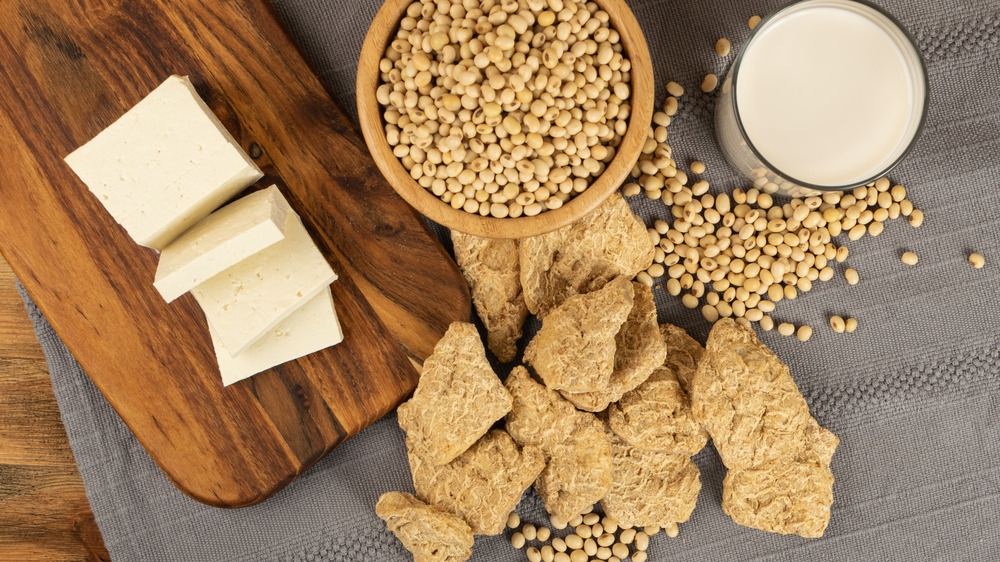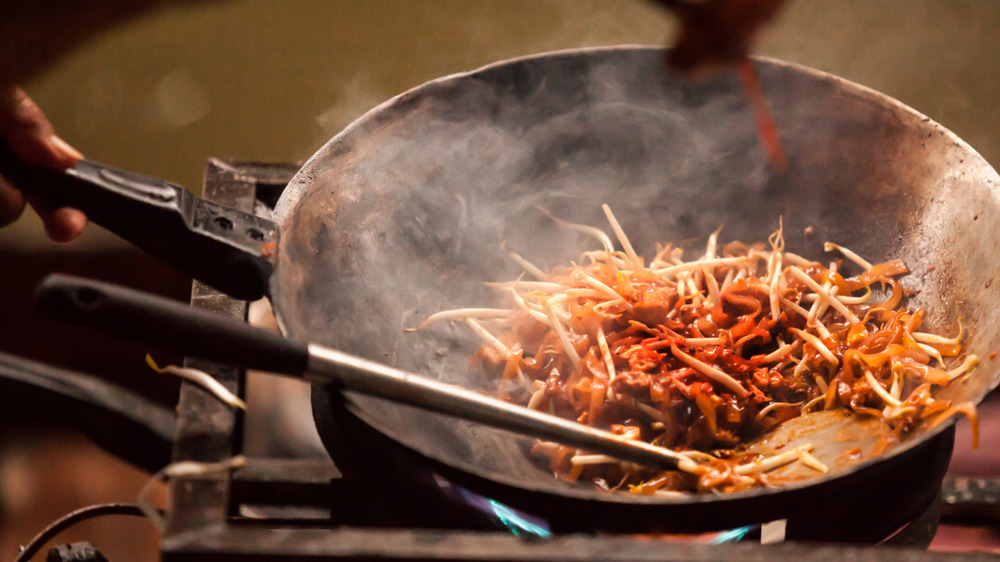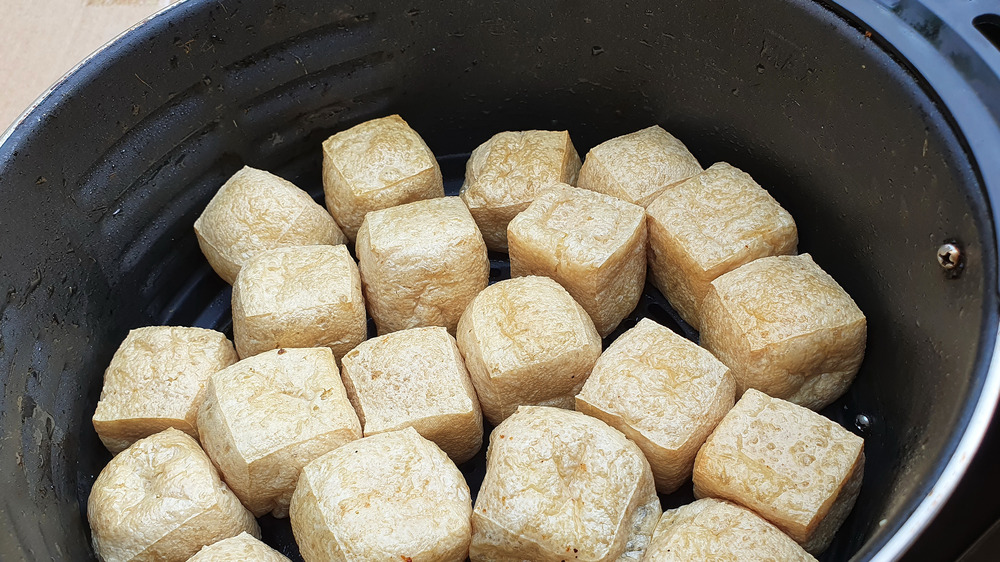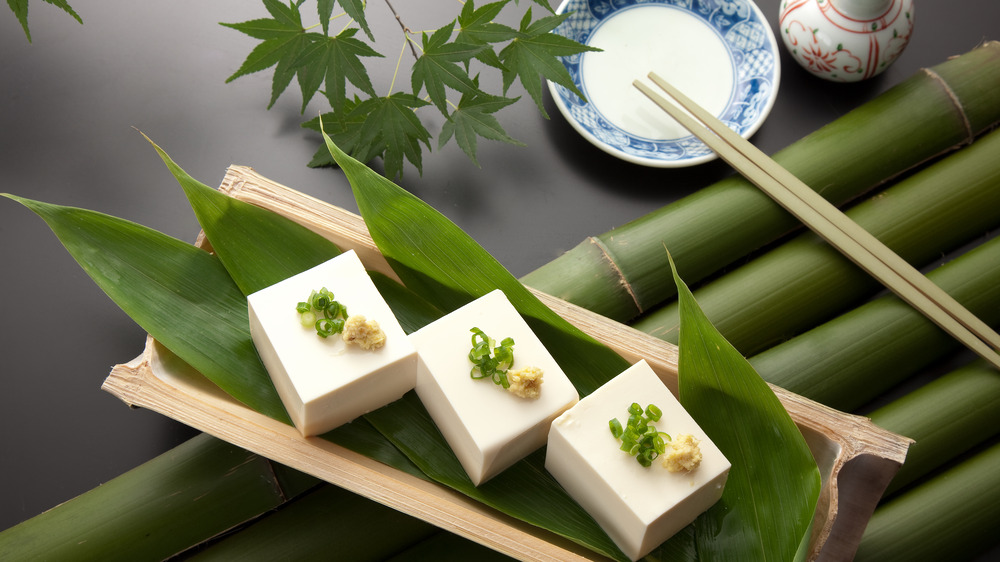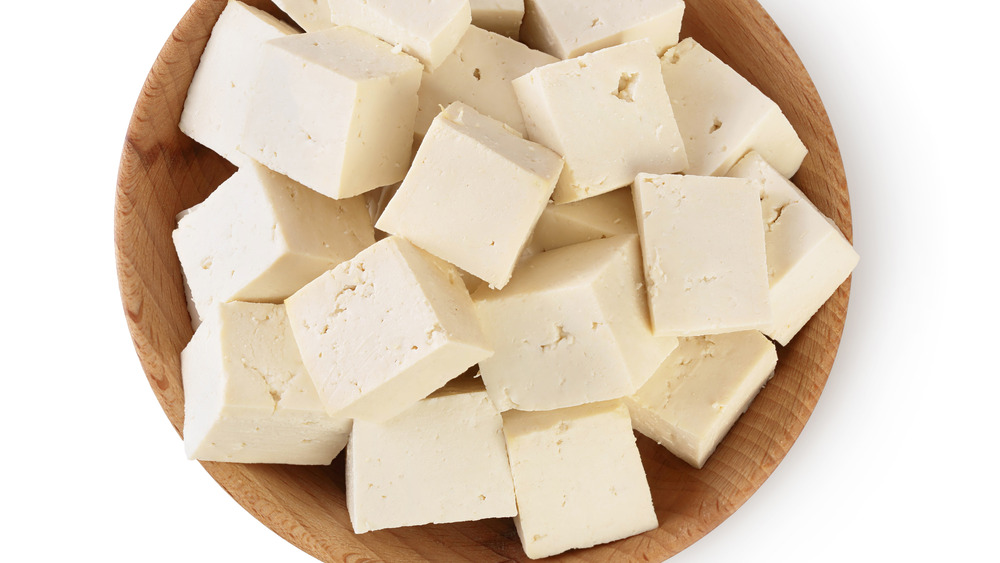Mistakes Everyone Makes When Cooking Tofu
Tofu may bring to mind bland health food enjoyed by vegans and fitness fanatics but the truth is, tofu is a pretty misunderstood ingredient, and that is worth exploring in the kitchen. It's easy to not understand quite how to flavor tofu or even how to incorporate it into dishes — but tofu actually has endless possibilities, be it breakfast, lunch, dinner, dessert, snack, or even as a topping! Whether used as a substitute for meat or eggs, or just because you love the taste of crispy golden nuggets of tofu, this soy product really is an incredible ingredient with an endless variety of uses.
Enjoying and appreciating tofu starts with understanding the components of the ingredient enough to know how to prep and cook it before you eat it. Otherwise, a mistake along the way can lead to tofu that is soggy and flavorless. That sort of disappointing tofu no one wants to eat that, no matter how healthy it may be.
Once you discover the secret to perfectly savory crispy golden tofu, though, you'll never avoid cooking tofu again!
Not picking the right type of tofu
Tofu may sound like a single ingredient, but it comes in many different forms that are used for many reasons, making it one ingredient that's actually many ingredients! Different types of tofu are best used in various ways, and choosing the right kind of tofu for your dish will impact the results you get, and how much you enjoy that dish you are making!
The four most common types of tofu are silken, firm, extra firm, and super firm. "The main difference between the types of tofu is how much it has been pressed," Jonghee Park, director of Nasoya Plant-Based Protein Innovation, told Mashed.
The level of tofu firmness to purchase for your recipe actually depends on the dish it's going into rather than your personal preference. "Soft tofu, which has a creamy, almost velvety texture, is best used as a healthy alternative in dips, smoothies, desserts to replace an egg or dairy product, and salad dressings. Medium Firm tofu works well when braised or boiled and is best used in casseroles, soups, and salads. Firm, extra firm, and super firm tofu are great as a meat substitute and ideal for stir-frying, air-frying, grilling, scrambling and much more," Tina Bui of House Foods, told Mashed.
Not pressing the tofu
Many recipes advise you to "press" your tofu, which essentially is just removing extra moisture before the flavoring and cooking stages. That may sound complicated, but it's actually quite easy and will make such a difference in how the dish comes out at the end.
"The simplest way to press tofu is with a tofu press, but if you don't have one, you can also drain the tofu from the package, wrap it in a clean cloth or paper towels, and weigh it down with some heavy books or another flat object with some weight for about 30 minutes," Jonghee Park, director of Nasoya Plant-Based Protein Innovation, told us. It works just as well in a pinch.
Another great tip is to wrap the tofu in a paper towel and then put it on a paper towel-lined plate. "Place a plate on the tofu and weigh it down with a can, then put it in the fridge overnight!" Food Network Star finalist and recipe developer for ChopHappy, Jason Goldstein, told Mashed.
If this all seems a little too complicated, you may just want to go ahead and buy a press. "You can easily purchase a tofu press online to help with this process," Willow Vegan Bistro and Beyond Sushi Executive Chef and owner Guy Vaknin, told Mashed. Vaknin shared one more trick: "just simply stack a few heavy plates on top of the tofu until the water drains out."
Not properly flavoring or seasoning your tofu
The biggest tofu mistake that people make while cooking it is not properly flavoring the tofu. "Without flavoring, tofu is bland and tasteless," Lynn Gantner, a certified holistic healthy aging coach, told Mashed. What's the point in eating any food, no matter how healthy it may be, if it's tasteless?
For Gantner, the following formula always results in delicious tofu slices or cubes: "I always use firm or extra-firm tofu. If using firm, I will press the tofu for about 15 minutes using a plate placed over the cube of tofu with a bowl of water on the plate to weigh it down. I then cube or slice the tofu, and then marinate it in a mix of my favorite flavorings, drain thoroughly and pat dry, and/or season heavily with my favorite spices being sure the tofu is thoroughly coated with seasoning," said Gantner. This can then be either sauteed with a tiny bit of coconut oil until golden brown or cooked in an air fryer until golden brown. "Even the tofu haters in my family love tofu cooked this way!" said Gantner.
Jonghee Park of Nasoya Plant-Based Protein Innovation, agrees. "Tofu is neutral in taste and therefore absorbs the flavors of other ingredients added to it, so marinating and seasoning tofu is so important to create bold and flavorful dishes," Park said. You can explore just about any flavor profile from Korean BBQ or sweet and spicy to cilantro-lime, or Mexican tacos.
You didn't try marinating your tofu
Back to the flavor aspect of tofu: marinating is another great way to get that tofu to be full of flavor. Marinating your tofu before cooking is one of the best ways to control its flavor, especially if you're cooking the tofu with other ingredients. However, you can't make a normal marinade for tofu, you have to leave out all the oil.
Remember, oil and water do not mix — and there'll always be some moisture retained in the tofu you're using. "The moisture in the tofu will reject the oil, preventing your marinade from soaking in and flavoring the tofu,"Heather Yan, founder of My Kitchen Culture, told us. This is why it's best to choose non-oily ingredients for your marinade, and then use oils and fats in the stir-fry to complete the flavor and help crisp the outside of the tofu. The reason for this is because the tofu will be great at absorbing the flavors in the marinade, but also the oils, according to Vegan Runner Eats. No one wants oily, greasy tofu, so choose those marinade ingredients wisely.
Not dehydrating the tofu
Much like with pressing to remove water from tofu, another important way tofu can take on a whole other dimension is when it is dehydrated. Dehydrating the tofu helps the tofu to take on a crunchier texture. "This can be done using any regular oven on low power over the course of a few hours, so it doesn't get too dry," Casper Ohm, founder of Water-Pollution.org.uk, and a vegan cook, told Mashed.
The key is to chop it up into cubes, especially if you plan to marinade it for a stir fry. "It's the best way to get that 'meaty' texture where it's crunchy on the outside and slightly tender in the middle," said Ohm. This is how you will want to stir fry tofu, and not when it's soft, since it will just fall apart when you try to mix it in with the vegetables, which is a common mistake for the novice tofu cook.
You cut the tofu into pieces that are too large
When picked up at the local supermarket or specialty store, tofu usually comes in a large block. The best way to get flavor into it is (after pressing, of course!) to cut that large block of tofu into smaller cubes.
The best way to do this is to cut it into thin slices when baking, suggests AllRecipes, or 1-2 inch cubes for stir-fries. This is because, with tofu, much of the flavor and texture comes from the surface according to Shape. So small cubes mean more of the tofu is full of flavor. And, isn't it more fun to just pick up a bite-sized chunk and eat it, rather than having to cut it to enjoy, anyway? We're all about simplified eating!
These small cubes will also be a better bet for sauteing and throwing into a stir fry, so it's a win-win scenario.
Your pan was not hot enough
Much like with a steak or a burger, to get a good sear, you need a good amount of heat! And with tofu, that golden crust is so important in taste and texture.
So the biggest mistake you can make when trying to sear tofu is a pan that is not hot enough! Make sure that the room temperature pan is heated up a good amount before you add the tofu. "Before you add tofu, give the oil and pan time to warm up so that the tofu gets an even blast of heat," explained Delish.
At that point, you just have to give the tofu time to get golden brown and crispy, because that's when it's best. According to Pinch Of Yum, the secret to that is to allow the tofu to cook, undisturbed for about 4-5 minutes or until the underside is golden brown and crispy. You'll know when it's done by that golden crust.
Then when you are done cooking, all you need to do is just plate your dish, and of course do any finishing seasoning, such as a bit of salt, and enjoy!
You didn't try to cook tofu other than in a pan
Sure, you can sear or saute tofu in a pan, and it will be delicious. It would be a mistake, though, to not try some of the other amazing ways to use tofu.
Tofu has so many possibilities. You can cook tofu in the oven, on the stove, in the air fryer, or on the grill. And according to the tofu guide on The Kitchn, the possibilities include everything from deep frying to baking it on a sheet pan or making it kebab style on a grill. Not done with the options? You can also scramble it and enjoy it as a vegan spin on a scrambled egg, or if you want to try everyone's current favorite trendy appliance — make it in the air fryer! That healthy variant doesn't even require cornstarch or deep frying, and will lead to the same golden crispy crust we all crave.
Not appreciating how versatile tofu is
Another mistake might be underestimating how extraordinarily versatile, delicious, and flavorful tofu can be. Tofu is great as a meat substitute or replacement for eggs, but this ingredient is so much more. It really is a healthy ingredient powerhouse and can be amazing to have in your kitchen arsenal.
"Our tofu has a meaty, hearty texture that plays many different roles in dishes," Hodo foods founder Minh Tsai told Mashed. This versatility in uses of tofu may include as "a topping for pizza or mixed into a salad" or eaten "with rice or quinoa bowls or in a noodle dish." Tofu's versatility is pretty limitless and Tsai says it works well when "put into tacos or sandwiches."
"We often describe tofu as both an art and a science — it has so many different properties, making it very malleable," Tsai added. So, experiment with your tofu and see just how much you can do with this easy-to-find and affordable vegan ingredient!
Your tofu wasn't fresh
A major mistake when cooking with tofu would be if your tofu is no longer fresh. No one wants to eat food that has spoiled!
Tofu may not involve meat or dairy, but it can still go bad, and if it's not at its best anymore, then you are probably better off not eating it. This is true as far as taste and dish quality, of course, but also, it's just not healthy.
As with any other ingredient, a good rule of thumb, according to EatByDate, is to just use your senses. This will tell you if your tofu has gone bad and is no longer safe to eat. EatByDate notes that some tofu red flags to watch out for are a change in color from white to a deeper tan tint. Also, keep an eye (or more accurately, a nose) out for a sour smell. Fresh tofu does not really smell, so if you smell something sour, that means that it'll taste sour as well. You won't be wanting to eat that!
The best way to make your tofu last longer safely is to keep it wrapped well and stored in the fridge after opening the package. It can also be stored in a freezer-safe container.
